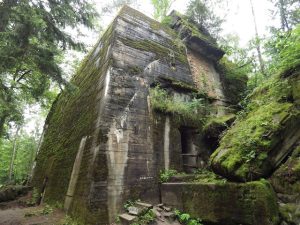Deep in the Masurian forests of former East Prussia is the crumbling structure of what was once Adolf Hitler’s secret headquarters on the Eastern Front of the Second World War. Today, the area is part of Poland and the place nearest to the ruins is Ketrzyn. It was once known as ‘Wolfsschanze’, German for ‘The Wolf’s Lair’. It once housed Hitler and nearly 2,000 of his staff from 1941, when it was built to the time of its destruction in 1945. The sprawling complex included 50 bunkers and 70 barracks with two airfields and a nearby railway station.

Hitler spent more than 850 days at the Wolf’s Lair from where he launched Operation Barbarossa, the Nazi invasion of the Soviet Union in June 1941. The complex served as Hitler’s headquarters when he launched the military operation. This led to growing dissatisfaction against the Nazi regime and on July 20, 1944, Claus von Stauffenberg, a colonel in the German Army acting along with many other conspirators made an attempt to assassinate Hitler at the complex as part of their secret operation codenamed Operation Valkyrie. The attempt however failed to eliminate Hitler.
Hosting the Nazi invasion of the Soviet Union
The complex was conceived in 1940 and its construction was completed on June 21, 1941, when Hitler had already invaded Czechoslovakia, Poland, Denmark, Norway, Holland, Belgium, Luxembourg, and France. Hitler moved into the Wolf’s Lair one day after the launch of Operation Barbarossa when three million German troops invaded the Soviet Union. The complex was thus made the de facto capital of the Nazi German operations on the Eastern Front.
The complex was strengthened with steel-enforced concrete walls which were 6.7 feet thick and were protected by anti-aircraft guns. Hitler’s private bunker had ceilings that were 26 feet thick. The military operations for all the military fronts which Germany was then fighting on were directed by Hitler from the Wolf’s Lair. The complex had all amenities which were needed by the Nazi leader including a barber salon, a restaurant, and also a casino.
The complex was crucial for Hitler as he had by then grown increasingly paranoid and erratic, especially after the Japanese attack on Pearl Harbor which had forced him to declare war on the US as a result of Germany being Japan’s ally. The Wolf’s Lair housed 2,000 people including high-ranking officials and soldiers as well as food tasters who were forced to taste the vegetarian meals prepared for Hitler for poison before he himself ate them.
One of Hitler’s former staffers named Margot Wolk recalled that some of the women who were food tasters used to cry when they began eating the food as they were afraid of being poisoned to death themselves. They had to wait an hour after having the meal and were very happy when they survived eating it. However, there was a conspiracy taking place in the complex which Hitler wasn’t aware of which was the plan to assassinate him.
Failure of Operation Valkyrie in the Wolf’s Lair
By 1944, many German Army officers had become disillusioned with Hitler’s uncontrolled lust for more power. They were also doubtful of his ability to make rational decisions. The German Army was in retreat on both the Eastern and the Western Fronts, especially after D-Day in June 1944. Claus von Stauffenberg, one of Hitler’s highest-ranking officers along with others plotted the attempt to assassinate Hitler at the Wolf’s Lair and turn over the control of the German capital, Berlin to the Reserve Army. The plot was codenamed Operation Valkyrie.
On July 20, 1944, Stauffenberg managed to secretly deposit a suitcase containing a bomb at a meeting attended by Hitler in the Wolf’s Lair. However, due to the suitcase being pushed away from Hitler at the last minute by another officer unintentionally, the blast was deflected away from Hitler and only caused him minor injuries. Stauffenberg and the other members of the conspiracy after being exposed were executed. Stauffenberg shouted ‘Long Live free Germany’ as he was shot by a firing squad.
Four months later, as the Soviet Red Army advanced to the borders of Germany in East Prussia, Hitler was forced to evacuate the complex on November 20, 1944. Though Hitler had ordered the complex to be destroyed in January 1945, many bunkers therein were too strong to be demolished.
The complex today
Nazi Germany surrendered one week after Hitler committed suicide in his Fuhrerbunker in Berlin on April 30, 1945. The Wolf’s Lair was abandoned after the war and was overgrown with moss. It eventually became a temporary paintball site and also a tourist spot to which travel was unregulated. The director of Poland’s Warsaw Uprising Museum called the complex a ‘grotesque Disneyland’.
Thankfully, the Polish Forestry Inspectorate took control of the site in 2017 and installed information panels with tourism guidelines and historical markers. Nowadays, an adjoining hotel restaurant serves ‘Wolf Soup’, and the meeting room where Stauffenberg tried to assassinate Hitler is being fully restored.
In addition, many artifacts like armored doors, stairs to Hitler’s bunker, and a stone bearing the symbol of the battalion which was responsible for Hitler’s safety were recently found at the complex. Around 300,000 visitors visit the site annually and pay a fee of $4 to learn about the history of the Lair.
However, some critics don’t want the site to become a place of pilgrimage for neo-Nazis and thus don’t want to accord any historic significance to it. It is hoped that the restoration of the Wolf’s Lair will be only used as an educational tool to inform coming generations about the history of the site.












